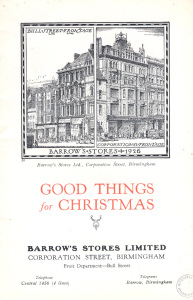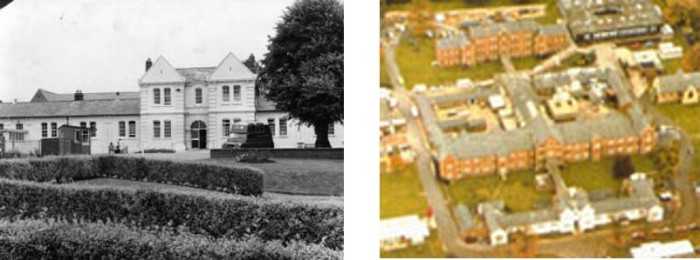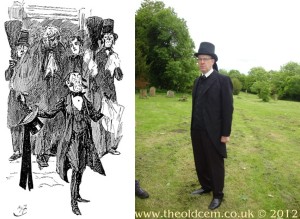Sometimes in research the phrase ‘merry little circles’ springs to mind! Working on the assumption that no individual deliberately sets out to misrecord information with the express intent of causing confusion, unravelling the story of Cecile Marjorie Heath Wilson has been one of said little circles. To begin with, she was always called Bridget although that name does not appear in her family or its records. Nothing has been found to explain this oddity but her probate record uses the name as if it were an official one so, somewhere along the line, the name Bridget has become appended to her other three forenames. It is parenthesised in her school records so would appear to have been in use for most of her life: it is not present on her birth record but it is on her death record.
Born in Wheatenhurst (now called Whitminster), Gloucestershire on 22nd September 1927, Bridget was the youngest child of George and Winnifred (spelled Winifred & Winnefred too) Wilson. Between the birth of older brother George Heath Wilson in Richmond and that of her sister, Barbara Heath Wilson, in 1923, the family had moved from Surrey to Gloucestershire. The astute amongst you will have detected a name pattern here – the Heath forename stems from the grandmother’s maiden name and was given to all three children. Unfortunately, the son being called George as well as the father inadvertently caused a great deal of confusion to all and sundry including official recorders of information. Bridget’s school record gives her father’s name as George Heath Wilson and states that he was a sub-conductor in India. This is a Warrant Officer not attached to a specific regiment and usually working for the Public Works Department. Then it also said he was a Squadron leader, DSO, DFC and had died but neglected to give a date. The two professional roles did not seem to fit together but it all took a considerable amount of unpacking! The search was not helped by the mother’s maiden name being recorded as Wood on Bridget’s birth record but elsewhere as Woods. (You sometimes have the feeling that the family historian god is a bit of a mischief maker.)
Tracking George Heath Wilson, DSO, DFC, it did not take long to find his name recorded on Runnymede Memorial as having died on 25th June 1944.

image from http://www.staffshomeguard.co.uk/
He was in RAF (VR) 139 Squadron and his plane took off
on the night of 24.June 1944 from RAF stn Upwood in company with nine other aircraft of the Squadron to carry out an attack on Berlin. The aircraft was not seen or heard from after take off and failed to return to base.
http://aviation-safety.net/wikibase/wiki.php?id=121896
It had two crew: F/Lt William Wrixon Boylson DFC & Bar (pilot) RAAF and S/Ldr George Heath Wilson DSO DFC (nav.) RAFVR.
Via Googlebooks, this information was expanded upon.
A 139 Squadron Mosquito B.XX, one of the 27 that went to Berlin, was shot down thirty kilometres northwest of the ‘Big City’ by Leutnant Ernst-Ewald Hittler of 3./NJG1 for his fifth and final victory. Twenty five year old Flight Lieutenant William Wrixon Boylson, DFC RAAF and Squadron leader George Heath Wilson, DSO DFC were killed.
German Night Fighters Versus Bomber Command 1943-1945 by Martin W Bowman, Casemate Publishers, 2016.
Although the age of the pilot was given, George’s age was not and no details of this appeared on the CWWG website either. It was only when a newspaper report from the previous year was found, announcing his being granted the DSO and which stated that he had been born in 1920, that it became clear (well, slightly clearer!) that Sub-conductor George and Squadron leader George could not be the same person. Not even the most highly decorated officer is a father at the age of 7! However, they could be – and indeed were – father and son. Although the father is not recorded officially as George Heath Wilson (only ever as George), it may well be one of those family things, like the addition of the name Bridget, known within the family but not written down.
Once it became clear that Squadron leader George was not Bridget’s father but her brother, the hunt was on for Sub-conductor George. Finally, a breakthrough came when a British India Office marriage was found for a Winnefred Blanche Woods to a George Wilson in Simla in 1919. As the names of the couple’s fathers were also given, it became much more straightforward to trace the correct families.
George Wilson, then, was born in Moreton in the Marsh in 1879 and in 1891 he was with his parents, their address given as Police Station, Bristol Road, Wheatenhurst where Edmund Wilson was a police sergeant. “A police station with a petty sessions court was built at the junction of the main road and School Lane in 1867” http://www.british-history.ac.uk/vch/glos/vol10/pp289-291
Winnifred was thirteen years younger than her husband. She had been born in Portsmouth in 1893 and her father, Arthur John Woods, was a Staff Sergeant in Bengal, India (Unattached List). Given that Winnifred’s siblings were all born in India, it is possible that the family returned there as they do not appear on many census returns in UK. At the time of her marriage, Winnifred was a clerk in Q M Gant’s branch which might suggest that she and George met in India although we cannot be certain of this. Within a year of their marriage, the newly-married Wilsons returned to UK where George Heath Wilson was born. They were clearly still in UK in 1923 and 1927 when their daughters were born. Sadly, George died in 1933 and this made Bridget eligible for a place at the school. She was certainly there by 1939 as she is listed on the national register at the school and she appeared in a school performance of Quality Street (Barrie) at about this time. (The date of the performance is unknown, just a cast list in records, but the names on it place it about 1938/9.) This comic play was so popular that
Quality Street chocolates and caramels were named after it, and the confectionery originally used characters from the play in their advertising and packaging
Quality Street candy history. Société des Produits Nestlé S.A., accessed 2 March 2010, cited by Wikipedia.
Having become a pupil after her father’s death, Bridget’s young life was once again touched by tragedy when her mother died in 1943 and then her brother in 1944. She left school in 1945 with, amongst other accolades, Grade VIII piano (distinction) and a good school certificate result. Perhaps Nietzsche’s aphorism may well be true here: what doesn’t break individuals makes them stronger. Bridget went to Gloucestershire Training College of Domestic Science and qualified in 1948 with a 1st class certificate and had a post as Head Cook, Barrows’ Stores, Birmingham.

http://www.mawddachdreams.co.uk/about-me-my-home/52-barrow-stores-birmingham-s-fortnum-mason.html
Barrows, very much a landmark building in Birmingham was begun by a member of the famous Cadbury family. (That’s the second confectionery item in this post!) John Cadbury, b 1801,
… took an apprenticeship with a tea company in Leeds, and upon his return to Birmingham in 1824, he borrowed money from his father to start a business. He opened a shop on the 4th March 1824 at 93 Bull Street, next door to his parents, selling tea and coffee.
http://www.bhamb14.co.uk/index_files/CADBURY.htm
The store was well known throughout the Midlands and
By 1905 the store had been rebuilt with a new cafe on the first floor for the customers to try the companies [sic] products, and had numerous departments from glass & china to food … This new premises incorporated a ‘restaurant’ that was opened on the first floor of the stores in 1905, partly so that customers could sample the tea and coffee sold by Barrows. It sounds tempting to the weary shopper: The Cafe has large windows overlooking Corporation Street, from which a peep of the busy throng below can be obtained.
(http://www.mawddachdreams.co.uk)

This picture of the store is taken from the 1926 Christmas List. Image from https://theironroom.wordpress.com/2011/12/19/barrows-stores-christmas-list/
Presumably, it was not tempting enough to keep Bridget as by 1950 she was the cook at the Royal Masonic Hospital (school magazine 1950)

Images of hospital from http://ezitis.myzen.co.uk/ravenscourt.html
After her post at the Royal Masonic Hospital, she was a cook at a Holiday fellowship Hostel in Conway and later Head Cook at a Scottish hostel near Loch Lomond; then she had entered the Glasgow College of Domestic Science to study dietetics (school magazine 1951)

Image of College http://www.theglasgowstory.com/image/?inum=TGSG00044
Now the Glasgow Caledonian University, it was at the time a Cookery College known affectionately as the Dough School.

Image from http://www.gcu.ac.uk/media/gcalwebv2/cshhh/content/documents/THE%20DOUGH%20SCHOOL%20BROCHURE%20.pdf
Dietetics, which had been taught at the College since 1925, was formulated into a diploma course in 1954. Students on this postgraduate diploma course received training in nutrition and diet therapy, biochemistry, bacteriology, physiology and chemistry, and undertook a six month placement in a hospital dietetics department. The course offered some women an opportunity to establish a career in a relatively new field of health and medicine. http://www.gcu.ac.uk/media/gcalwebv2/cshhh/content/documents/THE%20DOUGH%20SCHOOL%20BROCHURE%20.pdf
Bridget’s excellent school record tells one story but her post-school career suggests another – that she was rather unsettled. Having qualified in 1948 she had a post in Birmingham; moved in 1950 to London and a new post as hospital cook; moved again the following year and then two other posts (one in Wales, one in Scotland) and all before she entered the Glasgow College of Domestic Science to study dietetics. As this was all reported in the school magazine of 1951, it does reflect a rather hectic and unsettled period. In 1953 she was on the move again. This time to India (her sister was living there) where travel documents give her as a dietitian [sic] and she went from there to New Zealand before returning to India. Finally, she returned to UK via S Africa and took up a post as Assistant District Caterer for Oxford Geriatric Hospital.

In 1951 the first geriatric day hospital in the country was opened on the site. [Cowley Road] It was under the United Oxford Hospitals until 1974, when responsibility passed to Oxfordshire Area Health Authority (Teaching). The hospital functioned as a geriatric unit from 1958 until closure
images above and text http://www.oxfordshirehealtharchives.nhs.uk/hospitals/cowley_road.htm
As so many hospitals, it began life as the Workhouse. It was eventually demolished in 1981.
Bridget clearly maintained her contact with the school throughout her travels. It would have been impossible to reconstruct her story without this as she and her sister only appear on records fleetingly. One of these fleeting records gives us the information that she died at the Radcliffe Infirmary in 1966, her death reported in the magazine. She was living at 3 Crown St, Oxford at the time, her probate record informs us.

Google Earth Street view 2015 https://www.google.co.uk/maps
Despite the difficulties in unpacking the records, it is possible to re-construct a life. It just takes longer! What we can never learn from the records, however, are the emotions behind the story. Bridget was only 38 when she died and she did seem to have packed a lot into her life but whether she was escaping from or to something is merely speculation.




